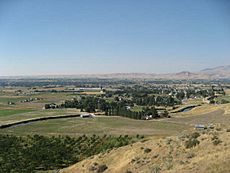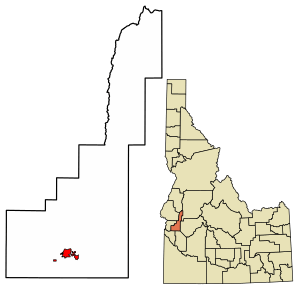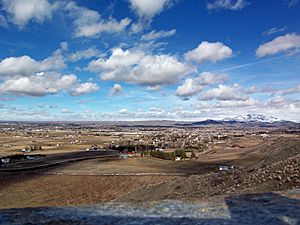Emmett, Idaho facts for kids
Quick facts for kids
Emmett, Idaho
|
|
|---|---|

View of Emmett
|
|

Location of Emmett in Gem County, Idaho.
|
|
| Country | United States |
| State | Idaho |
| County | Gem |
| Area | |
| • Total | 2.62 sq mi (6.79 km2) |
| • Land | 2.60 sq mi (6.74 km2) |
| • Water | 0.02 sq mi (0.05 km2) |
| Elevation | 2,379 ft (725 m) |
| Population
(2010)
|
|
| • Total | 6,557 |
| • Density | 2,710.99/sq mi (1,046.56/km2) |
| Time zone | UTC-7 (Mountain (MST)) |
| • Summer (DST) | UTC-6 (MDT) |
| ZIP code |
83617
|
| Area code(s) | 208 |
| FIPS code | 16-25570 |
| GNIS feature ID | 2410437 |
Emmett is a city located in Gem County, Idaho, in the United States. It is the main city and the county seat of Gem County, which means it's where the county government is located. In 2010, about 6,557 people lived there. Emmett is also part of the larger Boise−Nampa area, which is a big group of cities and towns.
Contents
Discover the History of Emmett
Emmett started as a small town on the southern bank of the Payette River. It grew around a place where people could cross the river using a ferry.
How Emmett Got Its Name
The town was first called Martinsville. It was named after Nathaniel Martin, who helped build the ferry crossing. Later, the name changed to "Emmettville." This was because the local post office was named after Emmett Cahalan, whose father was an early settler. Eventually, the "ville" was dropped, and the town became simply Emmett.
Growth and Development in Emmett
In 1883, James Wardwell officially planned out the town. Emmett became an incorporated city in 1900. This meant it had its own local government. A few years later, in 1902, the Idaho Northern railroad arrived, helping the town grow even more.
After the local mines closed in 1906, electricity came to Emmett. New irrigation projects helped the town expand rapidly. Emmett became a major center for farming and fruit growing. In the early 1900s, fruit companies called the valley the "Gem of Plenty" because the land was so good for growing crops.
Important Events and Landmarks
In 1934, a politician named Robert M. McCracken sadly passed away in a car accident near Emmett. He was campaigning to return to Congress at the time.
Until 2001, a large manufacturing company called Boise Cascade had a factory in Emmett. East of the city, you can find the Black Canyon diversion dam on the Payette River. This dam was built in the early 1920s.
Natural Features and Early Settlers
North of the valley stands Squaw Butte, a mountain about 5,906 feet (1,800 meters) tall. Native Americans used this area as a winter home. The Payette River is named after Francois Payette. He was a fur trader from Quebec who explored the area in the early 1800s.
People started settling permanently in the Emmett area in the 1860s. This happened after gold was found in the Boise Basin. Many people traveled through the area on trails, and two of these trails met near the Payette River in Emmett.
Exploring Emmett's Geography
Emmett is located south of the Payette River. It sits at an elevation of about 2,362 feet (720 meters) above sea level. The city covers a total area of about 2.82 square miles (7.30 square kilometers). Most of this area is land, with a small part being water.
Emmett's Climate
Emmett has a semi-arid climate. This means it has cold, moist winters and hot, dry summers. It's not extremely wet or extremely dry.
| Climate data for Emmett, Idaho, 1991–2020 normals, extremes 1906–present | |||||||||||||
|---|---|---|---|---|---|---|---|---|---|---|---|---|---|
| Month | Jan | Feb | Mar | Apr | May | Jun | Jul | Aug | Sep | Oct | Nov | Dec | Year |
| Record high °F (°C) | 63 (17) |
71 (22) |
82 (28) |
94 (34) |
100 (38) |
110 (43) |
111 (44) |
109 (43) |
103 (39) |
95 (35) |
76 (24) |
74 (23) |
111 (44) |
| Mean maximum °F (°C) | 52.2 (11.2) |
59.1 (15.1) |
70.0 (21.1) |
79.7 (26.5) |
89.3 (31.8) |
97.0 (36.1) |
103.0 (39.4) |
101.1 (38.4) |
94.2 (34.6) |
83.1 (28.4) |
64.7 (18.2) |
56.1 (13.4) |
103.9 (39.9) |
| Mean daily maximum °F (°C) | 38.3 (3.5) |
46.0 (7.8) |
55.9 (13.3) |
62.8 (17.1) |
72.3 (22.4) |
80.9 (27.2) |
91.7 (33.2) |
90.4 (32.4) |
79.7 (26.5) |
65.2 (18.4) |
49.2 (9.6) |
38.9 (3.8) |
64.3 (17.9) |
| Daily mean °F (°C) | 30.8 (−0.7) |
36.3 (2.4) |
43.9 (6.6) |
49.3 (9.6) |
57.9 (14.4) |
65.6 (18.7) |
74.7 (23.7) |
73.5 (23.1) |
64.0 (17.8) |
51.6 (10.9) |
39.1 (3.9) |
31.2 (−0.4) |
51.5 (10.8) |
| Mean daily minimum °F (°C) | 23.3 (−4.8) |
26.6 (−3.0) |
31.8 (−0.1) |
35.8 (2.1) |
43.5 (6.4) |
50.3 (10.2) |
57.6 (14.2) |
56.5 (13.6) |
48.2 (9.0) |
38.1 (3.4) |
29.1 (−1.6) |
23.5 (−4.7) |
38.7 (3.7) |
| Mean minimum °F (°C) | 9.0 (−12.8) |
15.1 (−9.4) |
22.0 (−5.6) |
26.3 (−3.2) |
31.7 (−0.2) |
39.6 (4.2) |
48.2 (9.0) |
47.5 (8.6) |
37.6 (3.1) |
25.8 (−3.4) |
16.7 (−8.5) |
10.5 (−11.9) |
4.5 (−15.3) |
| Record low °F (°C) | −27 (−33) |
−16 (−27) |
6 (−14) |
12 (−11) |
23 (−5) |
30 (−1) |
35 (2) |
31 (−1) |
21 (−6) |
12 (−11) |
−13 (−25) |
−27 (−33) |
−27 (−33) |
| Average precipitation inches (mm) | 1.77 (45) |
1.26 (32) |
1.60 (41) |
1.22 (31) |
1.47 (37) |
0.77 (20) |
0.25 (6.4) |
0.17 (4.3) |
0.42 (11) |
0.90 (23) |
1.33 (34) |
2.12 (54) |
13.28 (338.7) |
| Average snowfall inches (cm) | 1.7 (4.3) |
1.4 (3.6) |
0.1 (0.25) |
0.1 (0.25) |
0.0 (0.0) |
0.0 (0.0) |
0.0 (0.0) |
0.0 (0.0) |
0.0 (0.0) |
0.0 (0.0) |
0.5 (1.3) |
3.6 (9.1) |
7.4 (18.8) |
| Average precipitation days (≥ 0.01 in) | 11.2 | 9.3 | 10.8 | 9.6 | 8.9 | 6.1 | 2.1 | 1.9 | 3.8 | 6.2 | 9.5 | 11.9 | 91.3 |
| Average snowy days (≥ 0.1 in) | 1.6 | 1.3 | 0.3 | 0.1 | 0.0 | 0.0 | 0.0 | 0.0 | 0.0 | 0.0 | 0.3 | 2.3 | 5.9 |
| Source 1: NOAA | |||||||||||||
| Source 2: National Weather Service | |||||||||||||
People Living in Emmett: Demographics
The population of Emmett has grown over the years. In 2010, there were 6,557 people living in the city. The population density was about 2,341 people per square mile. This means a lot of people live in a relatively small area.
| Historical population | |||
|---|---|---|---|
| Census | Pop. | %± | |
| 1910 | 1,351 | — | |
| 1920 | 2,204 | 63.1% | |
| 1930 | 2,763 | 25.4% | |
| 1940 | 3,203 | 15.9% | |
| 1950 | 3,067 | −4.2% | |
| 1960 | 3,769 | 22.9% | |
| 1970 | 3,945 | 4.7% | |
| 1980 | 4,605 | 16.7% | |
| 1990 | 4,601 | −0.1% | |
| 2000 | 5,490 | 19.3% | |
| 2010 | 6,557 | 19.4% | |
| 2019 (est.) | 7,054 | 7.6% | |
| U.S. Decennial Census | |||
Emmett's Population in 2020
In 2020, the United States Census counted 7,647 people living in Emmett. There were 2,773 households and 1,790 families. Most of the people living in Emmett were White (79.48%). About 13.39% of the population identified as Hispanic or Latino. People from many different backgrounds live and work in Emmett.
| Race | Number | Percentage |
|---|---|---|
| White (NH) | 6,078 | 79.48% |
| Black or African American (NH) | 19 | 0.25% |
| Native American or Alaska Native (NH) | 57 | 0.75% |
| Asian (NH) | 46 | 0.6% |
| Pacific Islander (NH) | 16 | 0.21% |
| Some Other Race (NH) | 30 | 0.39% |
| Mixed/Multi-Racial (NH) | 377 | 4.93% |
| Hispanic or Latino | 1,024 | 13.39% |
| Total | 7,647 |
Emmett's Population in 2010
In 2010, there were 6,557 people and 2,616 households in Emmett. About 33.6% of these households had children under 18 living there. The average household had about 2.46 people. The average family had about 3.12 people.
The median age in Emmett was 36.3 years old. This means half the people were younger than 36.3, and half were older. About 27.2% of residents were under 18 years old. About 17.4% were 65 years or older.
Transportation and Roads in Emmett
Emmett is connected to other towns and cities by state highways.
 - SH-16 goes south from Emmett. It connects to Eagle and Boise by linking up with SH-44.
- SH-16 goes south from Emmett. It connects to Eagle and Boise by linking up with SH-44. - SH-52 goes west towards Payette and Ontario. It also goes east towards Horseshoe Bend.
- SH-52 goes west towards Payette and Ontario. It also goes east towards Horseshoe Bend.
Education in Emmett
Emmett has its own school system called the Emmett Independent School District 221. This district covers all grades from kindergarten through 12th grade. Students in Gem County can also attend the College of Western Idaho.
Notable People from Emmett
Many interesting people have connections to Emmett:
- Carlos Bilbao is a member of the Idaho House of Representatives.
- Ammon Bundy is known as a leader.
- Hattie Johnson is an Olympic shooter.
- Brad Little is the current Governor of Idaho.
- Aaron Paul is an actor who has won an Emmy Award. He was born in Emmett.
- Clayne L. Pope is a professor of economics at Brigham Young University.
- Paul Graham Popham was a U.S. Special Forces member in Vietnam and a General Manager at McGraw Hill, Inc.
- Steven Thayn is a member of the Idaho Senate.
See also
 In Spanish: Emmett (Idaho) para niños
In Spanish: Emmett (Idaho) para niños



